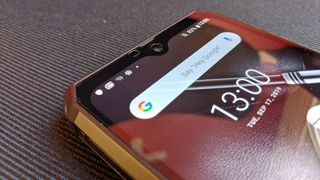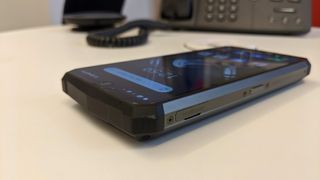TechRadar Verdict
The Blackview BV9100 has a battery capacity that surpasses most power banks. On top of that it has a relatively affordable price tag with a very decent set of components with only one chink to its armor; its processor.
Pros
- +
Obscene battery capacity
- +
Built like a rock
- +
Decent value for money
- +
Large screen
Cons
- -
Helio P30 performs poorly
- -
Bigger than expected
Why you can trust TechRadar
Online Chinese retailer, Aliexpress, sells the Blackview BV9100 for just under $270 at the time of writing, in silver or black frim. Note that, while this price includes delivery, it is exclusive of any taxes that may be levied by the relevant authorities or the courier companies on behalf of the vendor.
The race towards thinner and lighter smartphones while packing more powerful components usually causes one casualty; the battery life. A few smartphones have tried to buck the trend with limited success; the failed Energizer Power Max P18K Pop, with its 18,000mAh capacity and the 13,000mAh Ulefone Power 5S are the ones that come to mind.
Blackview has a new smartphone that wants to rival both; the brand new BV9100 has a 13,000mAh battery as well and is also a rugged device. Is it good enough though and does it have what it takes to be crowned the king of big-battery smartphones?
- Want to buy tech from online Chinese retailers? Read this first.

Design
At just under 19mm, the BV9100 is the thickest phone we have tested to date. That’s less than the P18K pop - which never saw the light of day as a product - but far more than the 16mm of the Power 5S. It is also heavier, far heavier, at 401g; in comparison, the Power 5S comes in at only 330g and the Anker PowerCore 13000, an external battery charger of similar capacity, weighs 255g.

In line with the usual Blackview design, it combines plastic covered with soft rubber and a metal frame (aluminum alloy) with a conservative grey/black colour scheme. The front facing tear drop camera is bang in the middle of the top edge of the display, not ideal. Next to it is a sensor and a LED.

On the sides of the device there are a SIM tray, a fingerprint reader, a custom button and the power button plus a volume rocker. On its back are two camera sensors and a LED flash.

A flap covers the USB Type-C connector on the bottom and there’s two speaker grills but only one speaker. The edges of the back are slanted to improve grip and reduce the perception of bulk.
Overall, a well constructed, sturdy, product that will withstand quite a few knocks and bumps. Note that it is an IP68/IP69K-rated smartphone.

Hardware
The Blackview BV9100 that was shipped to us came with the following hardware:
CPU: Mediatek Helio P35
GPU: IMG PowerVR GE8320
RAM: 4GB LPDDR4x
Storage: 64GB eMMC 5.1
Screen size: 6.3-inch
Resolution: 1080 x 2340
Weight: 401g
Dimensions: 171.3 mm x 80.2 mm x 19.5 mm
Rear camera: 16MP - Sony, 0.3MP - GC
Front camera: 16MP - Samsung
OS: Android 9
Battery: 13Ah
Well, the battery is the unique selling point of the BV9100 and at 13,000, it is the largest currently available on any smartphone on the market. Blackview claims that the device has a standby battery life of 1440 hours, that’s 60 days (or two months), an incredible number if true.
What’s even more mind-boggling is that the other claim about charging times; a mere 150 minutes from flat thanks to a 30W charger. You can also use it as a power bank thanks to the reverse charging feature.
Given its price, we were expecting some compromises; it offers a mainstream hardware combo. Mediatek Helio P35, 4GB of RAM (LPDDR4X) and 64GB onboard storage (the faster eMMC 5.1 version). That should be enough to last you a couple of Google Android generations (assuming that Blackview still supports this phone).
The 6.3-inch display has a 19.5:9 aspect ratio with a 1080 x 2340 resolution. No mention of Corning Gorilla Glass here but likely that the JDI-sourced panel has some sort of protective overlay.
A mention for the camera sensors; there’s three of them, two of which are 16-megapixel models. The one in front is a Samsung model (S5K3P9) while the pair at the back are Sony/GC ones, the latter being a 0.3-megapixel model.
Connectivity wise, there’s 802.11ac, Bluetooth 5, support for a navigation system and NFC. Note that there’s no wireless charging or an OTG cable. Note that it supports two 4G SIM cards simultaneously or one card and one microSD card.
Performance and in use
This is how the Blackview BV9100 performed in our suite of benchmark tests:
Geekbench: 178 (single-core); 909 (multi-core); Did not run (compute)
PCMark (Work 2.0): 5444
Passmark: 4351
Passmark CPU: 111714
Basemark: Did not run
Androbench (sequential): 291.13 (sequential read); 217.33 (sequential write)
Androbench (random): 42.74 (random read); 16.3 (random write)
3DMark Slingshot: 715
3DMark Slingshot Extreme: 476
3DMark IceStorm: 11833
HWBot Prime: 4374
The BV9100 has a near stock version of Android 9 Pie and offers face unlock. As for most Mediatek-powered rugged smartphones, there’s a toolbox folder with a few potential useful apps (useful if you are a DIYer that is). There’s a potentially useful translation app (which we haven’t used), an obsolete Blackview app, an FM radio and the ability to enable a child mode via an application.
Overall, the BV9100 put on an average showing. We have moved to Geekbench 5.0 so comparison with previous Geekbench 4.0 numbers would be futile and the Compute component of it didn’t work. As you’d expect, it simply cannot compete with other similarly priced phones with lower battery capacity and while it does struggle on high resolution games, we didn’t encounter any significant slowdown in everyday use.
Competition
Other than the phone itself, there’s a peelable screen cover, a manual, a USB cable, a Type-C to Type-C converter, a pair of USB earphones (which means you can’t listen and charge at the same time) and a fast charger. The latter has an “original blackview” sticker on it, alluding to a potential copycat problem. The charger provides up to 30W (5V, 6A) of power, one of the highest we’ve seen on a smartphone. Note that there’s no SIM tray needle.
The only meaningful competition the BV9100 has is the Ulefone Power 5S which we reviewed earlier this year; if you can find it anyway as stock seems to be patchy at the moment. It is more compact and lighter plus has more cameras (one extra in the front), wireless charging. On the other hand it has a weaker CPU, an older version of Android and no 802.11ac. And while it is solidly built, it is not actually a waterproof phone.
We’re keen to get out hands on the newly released Ulefone Armor 3W. It carries a similar price to the BV9100 with a slightly smaller battery capacity (10300mAh). Where it is superior though is the processor (a P70), two speakers, the camera (a 21-megapixel one) and the additional MIL-STD-810G certification.
Final verdict
You will buy this smartphone for its battery life and nothing else. Yes you can get a separate 13000mAh portable battery and a better smartphone for less but what you get in terms of value for money, you will lose in terms of flexibility and portability.
The Ulefone Power 5S probably edges it slightly when it comes to absolute value for money but it is not a truly rugged device and we found it difficult to source it online. The BV9100 is your best (and only) bet should you want to get a ruggedised smartphone that can accompany you for prolonged periods or can be used as emergency power bank for your team’s devices.
- Also check out our roundup of the best rugged smartphones of 2019

Désiré has been musing and writing about technology during a career spanning four decades. He dabbled in website builders and web hosting when DHTML and frames were in vogue and started narrating about the impact of technology on society just before the start of the Y2K hysteria at the turn of the last millennium.

